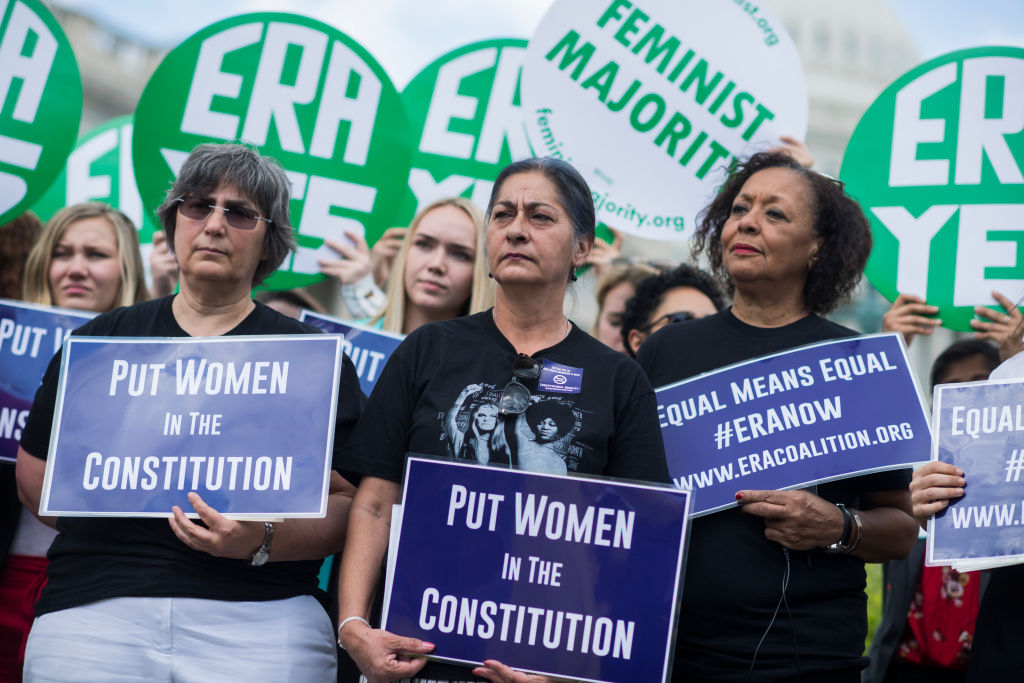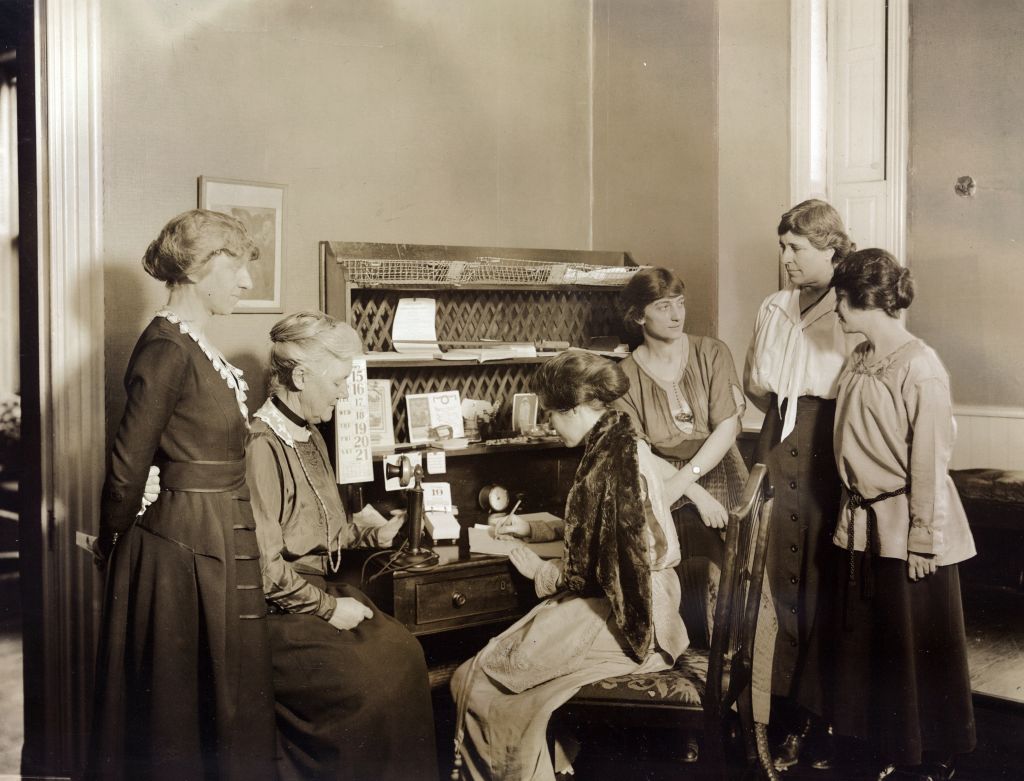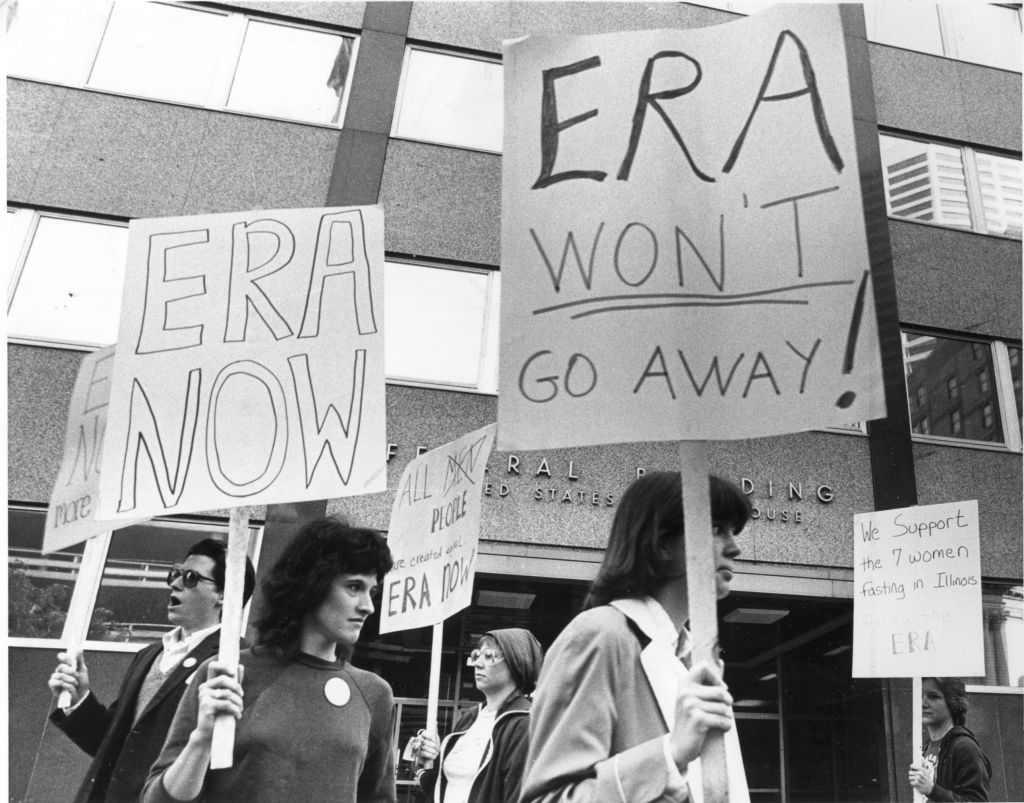
On Wednesday, Virginia became the 38th state to vote to ratify the Equal Rights Amendment — thus fulfilling the requirement that three-quarters of the states must approve an Amendment in order to add it to the U.S. Constitution. Since the Amendment was proposed a century ago, the U.S. has never been so close to enshrining the equality of all people, regardless of sex, in its bedrock legal document.
But that doesn’t mean the Equal Rights Amendment (ERA) will be added to the Constitution any time soon. There will likely be a long fight in the courts or in the U.S. legislature before that happens, as the legislators who originally passed the Amendment in 1972 set, and then extended, a time limit for ratification by the states. That deadline passed more than three decades ago.
ERA advocates note that this limit is not declared in the text of the Amendment itself — and regardless, Virginia’s decision is a historic moment for the rights of American women.
Here’s what to know about Equal Rights Amendment history and what could happen to it next.
What is the Equal Rights Amendment?
For a document that carries so much political weight and history, the Equal Rights Amendment is surprisingly short. As passed by Congress in 1972, the amendment said:
SECTION 1. Equality of rights under the law shall not be denied or abridged by the United States or by any State on account of sex.
SECTION 2. The Congress shall have the power to enforce, by appropriate legislation, the provisions of this article.
SECTION 3. This amendment shall take effect two years after the date of ratification.
The original amendment was written in 1923 by members of the National Woman’s Party, which itself was formed in June 1916 to push for women’s right to vote. After the 19th Amendment was ratified by on Aug. 18, 1920, the party turned its attention to the broader issue of women’s equality. The result: the ERA.
But the amendment failed to gain much widespread support in the 1920s partly because it divided members of the women’s movement along class lines. Working women at the time were focused on gaining workplace protections for women and children, and some were concerned that an Equal Rights Amendment would endanger laws that made factories safer and limited the number of hours women could work.
Decades would pass before the Equal Rights Amendment would gain real momentum. By that point, both men and women had won protections in the workplace, and the women of the second-wave feminist movement — including some who had participated in the fight for civil rights in the 1960s — were pushing for equality in their jobs, universities and homes.
Who first proposed the Equal Rights Amendment?

The Equal Rights Amendment was written by Alice Paul (1885-1977), the founder of the National Woman’s Party.
Born to a New Jersey family of Quakers who highly valued education, Paul studied at colleges and universities in the U.S. and the United Kingdom and earned an impressive number of degrees, including a Master’s and doctorate in sociology from the University of Pennsylvania, a law degree from Washington College of Law, and law Master’s and doctoral degrees from American University. But her life’s work really came into focus after she joined demonstrations for the British suffragist movement in the early 1900s. When she returned to the U.S. in 1910, she pushed American suffragists to try the confrontational techniques she’d seen applied in Britain, including civil disobedience.
Concerned that the National American Woman Suffrage Association was too moderate, in 1913 Paul and Lucy Burns formed the Congressional Union for Woman Suffrage, which was later reconstituted as the National Woman’s Party, and employed more aggressive tactics. The group used parades, petitions, protests and pickets to push for the right to vote. In 1917, Paul was sentenced to seven months in prison for picketing the White House, and was force-fed after going on a prison hunger strike.
After women successfully won the right to vote in 1920, the National Woman’s Party turned its attention to the next steps. Jessica Neuwirth, a women’s rights lawyer and a founder of the ERA Coalition, a current-day campaign to pass the amendment, tells TIME that suffrage advocates saw their work as remedying the intentional omission of women from the U.S. Constitution.
“It was an intentional exclusion of women from the constitution, because they were basically not considered full citizens who should have the right to vote,” Neuwirth says. “Once they got the vote, they wanted to get all the other rights that they should have.“
Paul’s crusade in the 1920s was unsuccessful, but in the 1950s, Michigan Congresswoman Martha Griffiths took up the torch. A former judge elected to the House in 1954, Griffiths worked to have sex discrimination added to Title VII of the 1964 Civil Rights Act and pushed the Equal Employment Opportunity Commission to double down on its enforcement of the Act. She also introduced the amendment on the House floor every year, but was unsuccessful until 1970, when Griffiths filed a discharge position that forced the legislation out of committee and led to the amendment being passed by the House. Although the Senate failed to pass it that legislative session, Griffiths reintroduced it the following year. It passed the House on Oct. 12, 1971 and the Senate on March 22, 1972.
Why did the Equal Rights Amendment of 1972 fail?

In passing the Equal Rights Amendment, Congress had set a seven-year deadline for ratification. At first, ratification seemed to be a given, with states quickly approving the amendment, but those ratifications slowed to a trickle. Crucially, the amendment’s passage had had a major consequence: mobilizing anti-feminists, including its arch-opponent Phyllis Schlafly, to defeat it.
In many ways, Schlafly was deeply contradictory. Although she praised stay-at-home mothers, Schlafly — a mother of six — dedicated much of her life to political organizing and traveled the country giving lectures. She believed that the ERA would do away with much of the special status granted to women, including the right to be supported by their husbands, and would damage the traditional American family. Schlafly founded the organization “STOP ERA” (an acronym for “stop taking away our privileges”) to oppose the Equal Rights Amendment.
“What I am defending is the real rights of women,” Schlafly once said. “A woman should have the right to be in the home as a wife and mother.”
Telling her audiences that the ERA would eventually lead to a future of gender-neutral bathrooms and women being drafted into the military, she successfully made many people think twice about what Constitutionally mandated equality of the sexes would mean. Deirdre Condit, an associate professor of political science at Virginia Commonwealth University, notes that in fact Schlafly was right that the future would include such things — but they came to pass even without the amendment.
“Well, if you fast forward to 2019, without the Equal Rights Amendment having passed, we’re trying to figure out how to deal with bathrooms in a multi-gendered universe. And we’re trying to figure out, should in fact women be drafted if men are drafted?” says Condit. ”And while we were are unsettled as a culture about these new questions, they did not fail to emerge because we didn’t have an Equal Rights Amendment.”
The deadline for ratification was extended by three years from 1979 to 1982. Still, when that deadline arrived, only 35 states had passed the amendment — three states short of the three-quarters majority required by the Constitution.
Condit notes that many of the states that failed to pass the Equal Rights Amendment had few women in their state legislatures, and historically had poor records of protecting the rights of both women and people of color.
Could the Equal Rights Amendment still be ratified today?

Virginia legislators’ decision to approve the Equal Rights Amendment means that the Amendment has fulfilled the requirement for three-fourths of the states to ratify a Constitutional Amendment. However, the ERA still faces another major obstacle: a past Congress had set a deadline for the Amendment’s ratification.
When that deadline passed in 1982, TIME reported that the Equal Rights Amendment had been “killed.”
Over the last five years or so, however, advocacy groups such as the ERA Coalition have help to renew the public’s interest in the amendment — and the possibility that it could still be ratified. Through their efforts, three more states ratified the amendment: Nevada on March 21, 2017, Illinois on May 30, 2018, and now, Virginia. In April of 2019, Congress held its first hearing on ratifying the Equal Rights Amendment in 36 years.
But what about that 1982 deadline?
Linda Coberly, a lawyer and the chair of the ERA Coalition’s Legal Task Force, tells TIME that she believes it’s possible to get around the deadline because that’s not part of the amendment itself, and the Constitution does not set deadlines for amendment ratification. In fact, the Constitution sets a requirement that one Congress can’t bind a future Congress, so modern legislators could alter the time frame.
“It would be unprecedented in our history for Congress to allow a joint resolution deadline to stand in the way of the effectiveness of an amendment that has been ratified by three-fourths of the states,” Coberly says.
Going forward, that means that Congress could potentially vote to eliminate the deadline, or it could be challenged in court.
How would an Equal Rights Amendment affect women’s rights?
Although American women have made significant gains in equality since the 1970s — and certainly since the 1920s — advocates say that an Equal Rights Amendment could still have a profound effect on the law and on American society.
Advocates say that the amendment is help back by the sense among some people that it’s not necessary, but proponents argue that it could strengthen the legal basis for combating violence against women, pay inequality and maternity leave.
Meanwhile, some contemporary opponents argue the amendment could have more of an impact than they’d want, for example leading to the striking down of laws that restrict access to abortion. Louisiana Rep. Mike Johnson raised these concerns during Congress’s hearing on the Amendment this spring. However, Coberly calls this line of thinking “fear-mongering” and points out that the Supreme Court has already upheld women’s right to seek an abortion, even without the ERA.
“Passing a constitutional amendment does not automatically invalidate anything,” Coberly says. “It would provide a basis, potentially, for a lawsuit, and courts will need to decide whether any particular law — whether it’s on abortion or something else — constitutes discrimination on the basis of sex and is invalid under any equal rights amendment.”
Professor Tracy Thomas of The University of Akron School of Law tells TIME that the law would prevent women’s rights from sliding back, and eliminate some “wiggle room” that leaves space in the law for stereotypes to affect civil rights. She also argues that protecting women’s rights in the Constitution would have a major cultural impact.
“There’s this overriding structure of the highest law in the land that has this absolute command, and so that has to trickle down,” says Thomas. She says that recent events such as the rise of the #MeToo movement reveal how quickly society can change. “Once you start changing the culture and the dialogue, things that were acceptable become unacceptable really quickly.”
Coberly notes that many people don’t even know that the U.S. hasn’t ratified the amendment yet. However, she feels that in the last few years, a growing number of people have come to believe that such a protection is important.
“I think there’s been a more widespread understanding among both women and men that we have not truly established equality in our culture,” she says, “and the laws that we have enacted are not sufficient to protect against sex discrimination in all avenues.”
More Must-Reads from TIME
- Cybersecurity Experts Are Sounding the Alarm on DOGE
- Meet the 2025 Women of the Year
- The Harsh Truth About Disability Inclusion
- Why Do More Young Adults Have Cancer?
- Colman Domingo Leads With Radical Love
- How to Get Better at Doing Things Alone
- Michelle Zauner Stares Down the Darkness
Contact us at letters@time.com